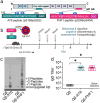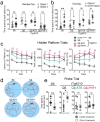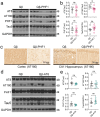This is a preprint.
Virus-like particle (VLP)-based vaccine targeting tau phosphorylated at Ser396/Ser404 (PHF1) site outperforms phosphorylated S199/S202 (AT8) site in reducing tau pathology and restoring cognitive deficits in the rTg4510 mouse model of tauopathy
- PMID: 38946961
- PMCID: PMC11213181
- DOI: 10.21203/rs.3.rs-4390998/v1
Virus-like particle (VLP)-based vaccine targeting tau phosphorylated at Ser396/Ser404 (PHF1) site outperforms phosphorylated S199/S202 (AT8) site in reducing tau pathology and restoring cognitive deficits in the rTg4510 mouse model of tauopathy
Update in
-
pS396/pS404 (PHF1) tau vaccine outperforms pS199/pS202 (AT8) in rTg4510 tauopathy model.NPJ Vaccines. 2025 May 13;10(1):94. doi: 10.1038/s41541-025-01147-4. NPJ Vaccines. 2025. PMID: 40360566 Free PMC article.
Abstract
Tauopathies, including Alzheimer's disease (AD) and Frontotemporal Dementia (FTD), are histopathologically defined by the aggregation of hyperphosphorylated pathological tau (pTau) as neurofibrillary tangles in the brain. Site-specific phosphorylation of tau occurs early in the disease process and correlates with progressive cognitive decline, thus serving as targetable pathological epitopes for immunotherapeutic development. Previously, we developed a vaccine (Qβ-pT181) displaying phosphorylated Thr181 tau peptides on the surface of a Qβ bacteriophage virus-like particle (VLP) that induced robust antibody responses, cleared pathological tau, and rescued memory deficits in a transgenic mouse model of tauopathy. Here we report the characterization and comparison of two additional Qβ VLP-based vaccines targeting the dual phosphorylation sites Ser199/Ser202 (Qβ-AT8) and Ser396/Ser404 (Qβ-PHF1). Both Qβ-AT8 and Qβ-PHF1 vaccines elicited high-titer antibody responses against their pTau epitopes. However, only Qβ-PHF1 rescued cognitive deficits, reduced soluble and insoluble pathological tau, and reactive microgliosis in a 4-month rTg4510 model of FTD. Both sera from Qβ-AT8 and Qβ-PHF1 vaccinated mice were specifically reactive to tau pathology in human AD post-mortem brain sections. These studies further support the use of VLP-based immunotherapies to target pTau in AD and related tauopathies and provide potential insight into the clinical efficacy of various pTau epitopes in the development of immunotherapeutics.
Conflict of interest statement
Competing interests All authors declare no competing financial or non-financial interests.
Figures





Similar articles
-
Virus-like particle (VLP)-based vaccine targeting tau phosphorylated at Ser396/Ser404 (PHF1) site outperforms phosphorylated S199/S202 (AT8) site in reducing tau pathology and restoring cognitive deficits in the rTg4510 mouse model of tauopathy.bioRxiv [Preprint]. 2024 Apr 9:2024.04.05.588338. doi: 10.1101/2024.04.05.588338. bioRxiv. 2024. PMID: 38644999 Free PMC article. Preprint.
-
pS396/pS404 (PHF1) tau vaccine outperforms pS199/pS202 (AT8) in rTg4510 tauopathy model.NPJ Vaccines. 2025 May 13;10(1):94. doi: 10.1038/s41541-025-01147-4. NPJ Vaccines. 2025. PMID: 40360566 Free PMC article.
-
Targeting of phosphorylated tau at threonine 181 by a Qβ virus-like particle vaccine is safe, highly immunogenic, and reduces disease severity in mice and rhesus macaques.Alzheimers Dement. 2025 Mar;21(3):e70101. doi: 10.1002/alz.70101. Alzheimers Dement. 2025. PMID: 40145301 Free PMC article.
-
In vivo tau PET imaging in dementia: Pathophysiology, radiotracer quantification, and a systematic review of clinical findings.Ageing Res Rev. 2017 Jul;36:50-63. doi: 10.1016/j.arr.2017.03.002. Epub 2017 Mar 15. Ageing Res Rev. 2017. PMID: 28315409
-
CSF tau and the CSF tau/ABeta ratio for the diagnosis of Alzheimer's disease dementia and other dementias in people with mild cognitive impairment (MCI).Cochrane Database Syst Rev. 2017 Mar 22;3(3):CD010803. doi: 10.1002/14651858.CD010803.pub2. Cochrane Database Syst Rev. 2017. PMID: 28328043 Free PMC article.
References
-
- Alzheimer A., Stelzmann R. A., Schnitzlein H. N. & Murtagh F. R. An English translation of Alzheimer’s 1907 paper, ‘Uber eine eigenartige Erkankung der Hirnrinde’. Clin Anat 8, 429–431 (1995). - PubMed
-
- Pevalova M., Filipcik P., Novak M., Avila J. & Iqbal K. Post-translational modifications of tau protein. Bratisl Lek Listy 107, 346–353 (2006). - PubMed
Publication types
Grants and funding
LinkOut - more resources
Full Text Sources

